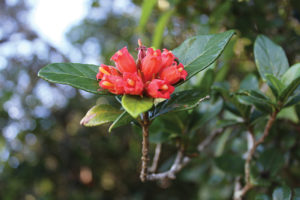
Name: Burchellia bubalina (L.f.) Sims
Family: Rubiaceae (Coffee, Madder or Bedstraw family)
Common names:
Engl. Wild Pomegranate,
Afr. Buffelshoring, Wildegranaat
Xho. Ithobankomo
Description
A shrub or small tree, usually 3-5 m in height but occasionally reaching 10 m; Bark: grey-brown, mottled, smooth, becoming rougher with age; young branchlets hairy. Leaves: simple, opposite, broadly ovate, softly to thickly leathery, glossy dark green, hairless or finely hairy, lateral veins indented above to give a quilted appearance, dull green with fine soft hairs, especially along the veins, below; apex tapering; base rounded to slightly lobed; margin entire, wavy, rolled under; petiole thickset, velvety; stipules leathery, toothed, falling early, leaving a conspicuous ridge. Flowers: showy, scarlet to orange; corolla tubular, urn-shaped; anthers joined to the upper section of the tube, filaments absent; calyx tube short; terminal, in shortly branched, 4 to 8-flowered heads; bisexual; floral parts in 5s; ovary 2-chambered (September-December). Fruit urn-shaped, rather leathery, reddish green to brownish, crowned with the 5 enlarged, persistent, horn-like calyx lobes (November onwards, remaining on the tree for months).
Conservation status
According to the SANBI (South African National Biodiversity Institute) Red list of South African Plants, Burchellia bubalina was not selected in any one of four screening processes for highlighting potential taxa of conservation concern for detailed assessment and was hence given an automated status of Least Concern (L.C.). http://redlist.sanbi.org
Distribution and habitat
Occurring in evergreen lowland and montane forest, at forest margins, in grassland and on rocky outcrops.
Provincial distribution: Eastern Cape, Free State, KwaZulu-Natal, Limpopo, Mpumalanga and Western Cape.
Derivation of name and historical aspects
The generic name Burchellia named in honour of an English explorer, naturalist, artist and author John William Burchell. The Afrikaans name, ‘Buffelshoring’, refer to the buffalo-like horns of the old calyx lobes on the fruit. When in life and flower it bears a somewhat superficial resemblance of the true pomegranate, and this has given rise to the common name ‘Wild pomegranate’.
Ecology
The flowers contain copious nectar and birds often slit the petal tube near the base to obtain the sweet liquid.
Uses and cultural aspects
The hard, dense and close-grained wood has been used for hut-building and for making agricultural implements. The roots, which are sometimes worn as an amulet, provide an infusion which is taken as an emetic and used as a body wash. Combined with the bark, they also make suitable splints for binding the fractured limbs of animals.
Growing Burchellia bubalina
Tolerance
The plants prefer areas where the frosts are not too severe, rainfall is high. Mature, established plants can survive mild frosty spells, but should always be sheltered from strong, cold winds. Extended periods of very cold weather may damage or even kill the plants. It is fairly resistant drought but need protection from extreme heat. In very warm or highveld gardens it should be planted in a protected spot where it will be sheltered by a larger tree or building during the hottest part of the day.
Lighting
They can thrive in semi – or deep shade, but the most prolific flowering will occur if they are planted in full sun.
Soil and Water
The plants prefer a compost rich, peaty or loamy soil (especially when freshly transplanted). They have moderate water requirements, but in very dry and hot areas, extra water should be given, every 3-5 days. A thick layer of mulch can be strewn around the plant to help the soil retain moisture.
Propagation
It is easily propagated from freshly harvested seed or semi-hardwood cuttings that are taken in late spring or in early autumn. Sow the seeds in a mixture of compost and fine river sand (1:2). They should be placed in a bright, warm, humid area, and misted often. Germination typically occurs within 4-6 weeks. Cuttings can be placed in a similar mixture and can be pre-treated with a rooting hormone, They take about three to four weeks to root and can then be transplanted into containers with potting soil for hardening off, before planting out in the garden.
References and further reading
Coates Palgrave, M. 2002 (third edition). Keith Coates Palgrave Trees of Southern Africa. Struik Nature, Cape Town


